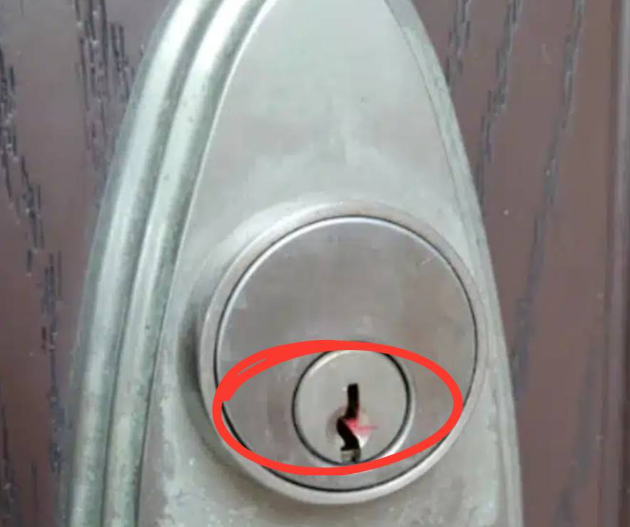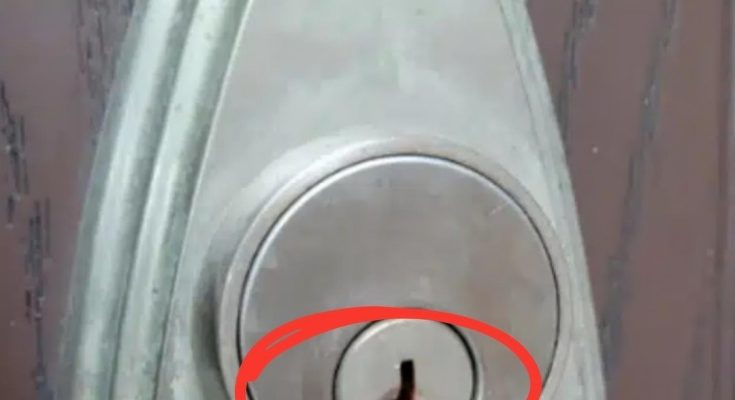magine coming home, inserting your key into the lock, and finding a small bit of red wax lodged inside. It might seem like a minor inconvenience, but it could signal something far more sinister. Red wax in your keyhole is not just random mischief—it’s a tactic used by burglars or squatters to identify vacant homes. This article will explore what this red wax means, why it’s used, and how you can protect your home from potential threats.

What Does Red Wax in Your Keyhole Indicate?
Finding red wax in your lock might not seem alarming at first, but it’s crucial to understand its implications. This unusual tactic is sometimes used by criminals to mark potential targets.
- Monitoring Occupancy: The presence of wax in your keyhole often serves as a test. If the wax remains undisturbed for a few days, it signals to the person who placed it that the house is likely unoccupied—making it an appealing target for a break-in or squatting.
- Easy Detection for Criminals: Wax is a discreet material that can be applied quickly without drawing attention. It’s not easily noticed, especially if you’re in a hurry. If you find it, it could be an early warning sign that someone has been near your home, assessing its accessibility.
Why Would Burglars or Squatters Use Red Wax?
The idea of criminals using wax to scout for potential break-ins might sound like something out of a spy novel, but it’s a real tactic.
- Low-Risk Marking: Wax is a subtle way for criminals to mark a property. It’s small, inconspicuous, and easy to remove once the job is done. If someone were to catch them placing it, they could easily pass it off as an innocent action.
- Effective Strategy: Because the wax is inside the lock, it’s less likely to be noticed by the homeowner at first glance. If left undisturbed, it gives criminals confidence that the property isn’t being closely monitored, encouraging them to move forward with a break-in or squatting attempt.
What to Do If You Find Red Wax in Your Keyhole
Discovering red wax in your keyhole can be unsettling. It’s important to act quickly and take the following steps to secure your home.
1. Inspect Your Property Thoroughly
Start by closely examining the area around your front door for additional signs of tampering.
- Look for Scratches and Marks: Check for scratches near the lock, marks around the door frame, or any other indicators that someone may have attempted to interfere with your lock.
- Assess Other Entry Points: Don’t limit your inspection to just the front door. Examine other potential entry points like windows, back doors, and garage doors for unusual marks or damage.
2. Change Your Locks Immediately
Regardless of whether the lock appears to be functioning normally, changing it is a wise move.
- Upgrade Your Security: Consider installing more secure locks or deadbolts. High-security locks are more challenging to tamper with, providing added protection against break-ins.
- Consult a Locksmith: A professional locksmith can assess your current security setup and suggest upgrades that will enhance your safety.

3. Install a Security Camera
Adding a security camera near your front door can be a strong deterrent against intruders.
- Doorbell Cameras: Devices like video doorbells can capture footage of anyone approaching your door. These cameras often have motion detection, alerting you to any suspicious activity in real-time.
- Visible Security: The mere presence of a visible camera can make potential burglars think twice before targeting your home.
4. Alert Your Neighbors
If you’ve discovered red wax in your keyhole, it’s important to inform your neighbors.
- Community Awareness: If burglars are targeting homes in your area, everyone needs to be vigilant. Encourage your neighbors to check their own locks and report any unusual findings.
- Establish a Watch System: If you live in a close-knit community, consider setting up a neighborhood watch program. Regular communication about suspicious activities can help prevent potential crimes.
5. Contact Local Law Enforcement
If you suspect tampering or find other signs of an attempted break-in, it’s crucial to involve the authorities.
- File a Police Report: Let local law enforcement know about the situation so they can investigate and monitor your neighborhood for suspicious activity.
- Increased Patrols: Reporting the incident might prompt an increase in police patrols in your area, enhancing overall security.
6. Invest in a Comprehensive Home Security System

If you don’t already have a home security system, this could be the perfect time to consider one.
- 24/7 Monitoring: Modern security systems offer features like motion detectors, alarms, and round-the-clock monitoring. These systems provide peace of mind by notifying both you and a monitoring service if suspicious activity occurs.
- Smart Home Integration: Many systems now offer smart features, allowing you to control your home’s security from your smartphone, even when you’re not at home.
Preventing Future Incidents: Tips for Enhanced Home Security
Securing your home from potential threats requires a proactive approach. Here are additional steps to prevent future incidents:
- Install Motion-Activated Lights: Bright lights can deter intruders, making them feel exposed and more likely to flee.
- Use Smart Locks: Smart locks offer keyless entry and can be monitored remotely. They can be an effective way to enhance home security.
- Reinforce Doors and Windows: Ensure that all doors and windows are sturdy and have reinforced locks to make entry difficult for potential burglars.
Conclusion: Take Red Wax as a Warning Sign
Finding red wax in your keyhole isn’t just an inconvenience—it’s a warning sign that someone may be targeting your property. By taking immediate action, such as inspecting your home, changing your locks, installing security cameras, and involving the authorities, you can protect your home and your peace of mind. Stay vigilant, communicate with your neighbors, and ensure that your home security measures are up to date. After all, prevention is the best form of protection against potential threats.



